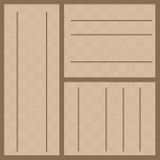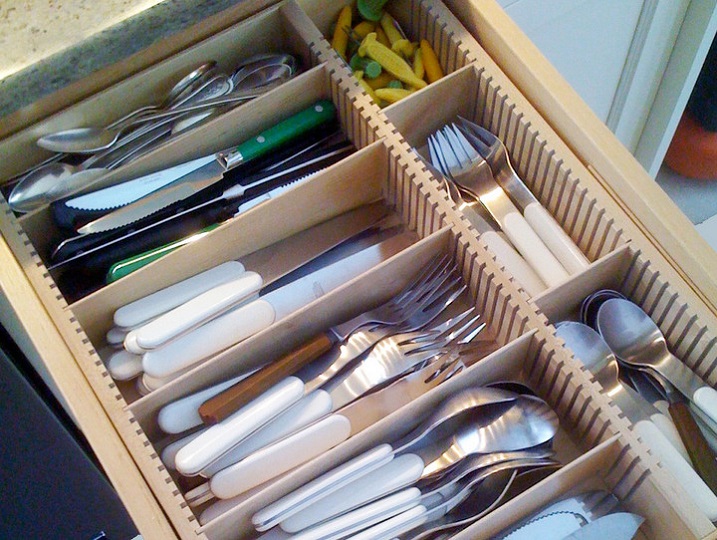Here’s a nice photo showing finished stock with unfinished ends. On display are the white, red, and brown personalities of maple.


The possibilities and practicalities of drawer organization
Here’s a nice photo showing finished stock with unfinished ends. On display are the white, red, and brown personalities of maple.

Maple has a well-established niche in the world of wood. Most of this reputation comes from its dependability:
It has a uniform density.
It has very few knots.
It is not porous (like oak, for example, which is essentially a bundle of tiny straws — one can actually breath through a board of oak if you put your lips against the end grain).
It resists splits.
It sands down to a very smooth surface.
But every now and then, Maple has its secrets and surprises. The occasional “tiger stripes” of maple are well-known and much prized.
Here’s another one: lenticularity.
Remember those lenticular cards you had when you were a kid? Held at one angle, they show one thing. At a different angle, they show something else.
Here’s a lenticular card made by Printshaq that you can twist to make it seem the butterfly is flapping its wings:

Well, occasionally you’ll find that same effect in maple. Here’s one I found recently.
Viewed from straight ahead:

Viewed from about 45 degrees to the side:

Pretty cool.
The tiger stripes, mentioned above, also often have a lenticular quality. Here are two photos of the same piece of wood. From the left angle, notice that the stripes are light-colored on a field of reddish wood…

From the right angle, the stripes look red on a field of tan…

Buyer “S” sent in this picture and had the following comments:
Hi Nathan [Thanks] for checking in! Yes I did receive the knife block and I have installed it into my drawer. It fits nicely. I then added all my knives. I am finding my 2 Chefs knives rock in their slots. I am concerned if the handles rock up, they will catch the drawer and prevent me from opening it. I have to be careful about my placement. I have sent a picture of what they look like. Also, I would have preferred the small knives all one side or another, not every other one, one large then small, then large, etc. It is a bit challenging to pull the small knives with a large knife on each side.

So first, about the rocking knives. We already wrote about this problem here, but S has helped us see there’s more to say.
S’s concern is legit, especially since he has the traditional high-quality “face frame” style of cabinet rather than the cheaper “Euro” style. This means he has a frame of 1.25 to 1.75″ (dimension shown in red in the photo below) around the face/opening of his cabinet, so there’s a large obstruction there to catch a rocking knife’s handle that sticks up too high.

In contrast, the Euro style has very little to catch on as you open the drawer. The photo below shows the panel above the drawer going back continuously to the back of the cabinet, meaning there would be nothing to catch on, but in my experience they would typically just have a strip of particle board there, ending at about the blue dotted line. So there’s still a chance of catching that, but less likely.

Either way, that’s a bad situation: something in the drawer has logjammed and you can’t open the drawer. Time to get clever and dextrous, I guess. Or else just go for brute force and hope there’s no damage resulting.
Here’s a possible cure for S’s “rocking knife” situation:
Commit to which knives will go in each slot and then put a little lift into the appropriate knife slots out near the tip.
A good material might be a little wad of plastic wrap stuffed down into the slot with a butter knife. That should hide neatly out of sight and be able to keep doing its job — without dulling the blade — in spite of getting rough treatment from the blade.
S also discusses the difficulty of accessing his smaller knives when sandwiched between the Chef’s knifes’ blades.

Yes. That’s awkward. We designed the knife block layout for allowing the maximum number of knives per drawer area, and that means we need to have the smaller knives’ handles nestled between the larger knives’ blades.
So, if you aren’t pressed for space, consider using a larger knife spacing or planning for some empty knife slots to allow quick access to your favorites.
Hello friends!
Well, 2020 was especially eventful for us and 2021 is promising to be the same. No doubt that’s the case for you as well.
But the quest for great organization never ceases, and Orderly Drawer is here for you.
Several new types of organizers are in the works. Join our mailing list to get updates about this and more.
Had the customer asked me about the feasibility of putting a cubby grid in a non-rectangular space, I would have advised against it. But he didn’t ask. He just designed and bought, approved the drawing, and after his order arrived, had been assembled assembled, and put in the drawer, he took the following image and sent it to me. That was the first time I knew about the curved drawer front.

No, it’s not perfect, but he says it works for him and he’s happy. Notice he filled in the gap in the front with glasses cases.
So there you have it. Now we know.
When a potential customer approached us about needing two grids — one for ties and one for belts — in the same large drawer I thought we were going to have to steer her towards a much more expensive maple insert as the solution. Remember: cubby grids can’t stand on their own. They need to have support from all four sides of the drawer, otherwise they’re a wobbly mess.
But I thought, “That will be so much more expensive. Let me think about it. Seems like there should be a way…”
After a day or two I found a solution. As long as there is a wall to serve as a support between the two grids, there’s no reason two cubby grids couldn’t sit side by side in the same drawer.
So here’s what we did. The customer planned one grid for ties and another for belts, and we reserved enough space to insert 1 or 2 acrylic walls between them. That “dividing” wall between the ties and belts below is nothing more than 2 pieces of acrylic she slipped between the two grids to tighten things up and give extra support all around.

Good question.
I’m not happy about the truthful answer, but here goes. You currently can’t save your work on our website. There. I said it. We plan to add that capability in the future, but it hasn’t yet worked its way to the top of the priority list.
Here’s what you can do…
Take a screenshot so that you can (relatively) quickly recreate your work if you’re not ready to purchase right now.
If you’re a designer working with a client, you can do the following:
Hopefully that helps. Let me know if you have additional questions about this topic.
“I don’t see quite the design I’m looking for. The attached drawing shows the drawer layout I want.”
– knows-what-he-wants customer

“Use our Kari template and plan the insert as if it were turned 180 degrees in your drawer. I hope that makes sense and that it works for you!”
– me

Here’s the Kari template. Do you see how it’s the same layout as his drawing, just upside down?
This strategy worked. He was able to design and purchase on our website, and here’s the feedback we received after he received his order.
“We love them, as do my in-laws.”
– knows-what-he-wants customer
Can’t beat that!

I received the following question from a customer:
We have ordered more movable dividers than we think we will use, just to have a few extra’s, so if you normally choose the location of the slots to allow even spacing, then for all movable dividers that are oriented from front-to back (the ones that are 7-5/8” and 10-1/2” in both drawers) please assume one less divider per section when determining that spacing. This will result in three 3-1/4” spaces across those sections of the first drawer (assuming 1/8” thick dividers), and five 3.45” spaces across those sections of the second drawer. If you don’t normally base the slot locations of the number of dividers, that’s fine. We’re not asking for something special. However, if the slot locations do normally take the number of dividers into account, then please make those determinations as described above.
Here is my response:
Good question. I understand about ordering extra dividers, but, no, we do not adjust the spacing of the slots based on the quantity of dividers.
Now you know.
Not long ago, a satisfied-but-less-than-thrilled knife block customer sent me a picture of his finished project.

Though the knife block is functional, some cooks might not like the levitating knife handle of the cleaver shown in this photo above. Others might love it. It would be easy to grab for a quick chop, chop, chop…

For handle-heavy knives, you might end up with a situation like the above. The handle of this butcher knife is resting on the block while the tip of the knife is exposed. Assuming the tip is towards to back of the drawer, this wouldn’t be cause for concern, but if the block was being stored in another orientation, that could be problematic.
Just understand that tall-bladed and long, handle-heavy knives might “sit” differently that expected in the knife block.